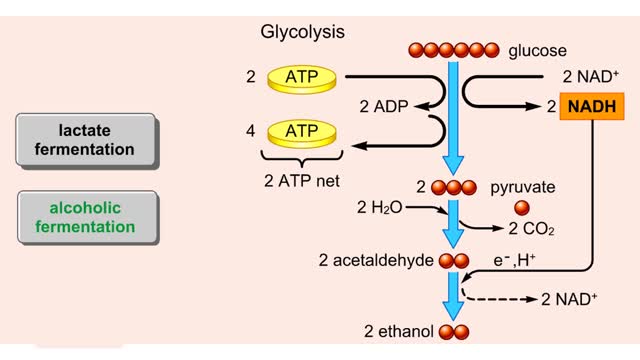Fermentation - When Oxygen Is Absent, Pyruvate to Lactate & Pyruvate to Ethanol
By: HWC
Date Uploaded: 02/18/2020
Tags: homeworkclinic.com Homework Clinic HWC Pyruvate glycolysis mitochondrion Krebs cycle fermentation NAD+ NADH single celled fungus fermentation of grape juice make beer make wine malt
Pyruvate is the end product of glycolysis. If oxygen is present, pyruvate enters the mitochondrion where further energy yielding reactions of the Krebs cycle will take place. However, if oxygen is not present, pyruvate will enter a pathway called fermentation. This pathway regenerates NAD+ from the oxidation of NADH. The NAD+ will be used again in the reactions of glycolysis. Let's see how pyruvate is modified in the reactions of fermentation. When we exercise vigorously, our muscle cells may become depleted of their supply of oxygen temporarily. Pyruvate then is reduced to lactate when NADH donates two hydrogen electrons and one proton (H+). A second proton (-14-) is picked up from the aqueous solution. Plants and yeast (a single-celled fungus) have an alternative fermentation pathway that produces ethyl alcohol and carbon dioxide instead of lactic acid. In this two step reaction, pyruvate loses a carbon atom in the form of carbon dioxide. The resulting molecule is acetaldehyde which then is reduced by NADH to ethyl alcohol. Notice how NAD+ is regenerated again. The brewing and baking industries make use of this type of fermentation where the release of CO2 causes bread to rise and alcohol accumulates during fermentation of grape juice (to make wine) or malt (to make beer).
Add To
You must login to add videos to your playlists.
Advertisement












Comments
0 Comments total
Sign In to post comments.
No comments have been posted for this video yet.